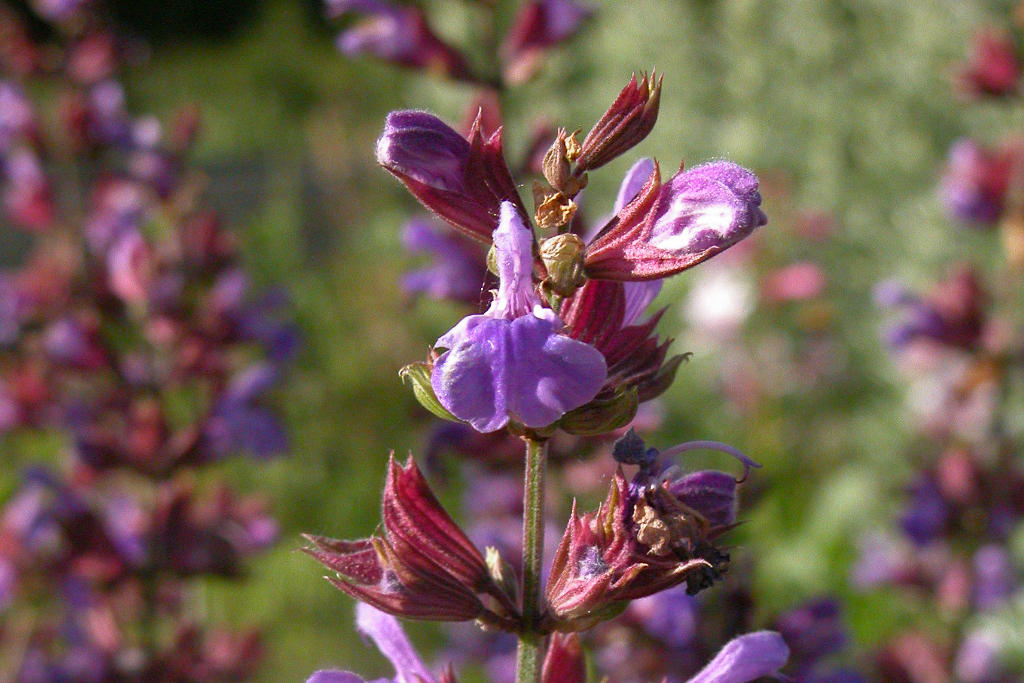Sage
Salvia officinalis L.
Lamiaceae
For this first plant of the month we start with one of the most prestigious one. Its Latin name bears witness to its virtues, Salvia which comes from the Latin salvare, to save, and officinalis, in connection “officines” which means pharmacies.
So why start with Latin? For there is not one sage but many, even hundreds, that spread from Europe to America. And it is this Latin name, followed by the first letter of the first botanist to have described the plant in detail, which makes it possible to be sure to we are speaking of the right plant. L. means, for example, that it is Linnaeus who has described this sage in particular.
Our sage is native to the eastern Mediterranean coast, Greece, Albania … where it grows in the dry mountains, on rocky and poor soil. To preserve its aroma and virtues it will be necessary to cultivate it in similar conditions.
Sage has been used since antiquity, and its use has not weakened in the course of history. The adage even says: “Why dies, the man whose sage grows in the garden!”
Its other action is more specific on the female cycle, to encourage menstruation, relieve from the pain when they are painful or to fight the discomforts of the menopause. These actions are due in particular to phyto-osteogens … natural compounds that act as the estrogen (female hormone) of the body. For this reason the plant is contraindicated in children, during pregnancy and in case of breast cancers.
Son autre action est plus spécifique sur le cycle féminin, pour favoriser la venue des règles, les soulager quand elles sont douloureuses ou encore combattre les inconforts de la ménopause. Ces actions sont dues en particulier à des phyto-ostéogènes … des composés naturels qui agissent comme les œstrogènes (hormone féminine) du corps. Pour cette raison la plante est contre-indiquée chez les enfants, pendant la grossesse et en cas de cancers du sein.
Its other action is more specific on the female cycle, to encourage menstruation, relieve from the pain when they are painful or to fight the discomforts of the menopause. These actions are due in particular to phyto-osteogens … natural compounds that act as the estrogen (female hormone) of the body. For this reason the plant is contraindicated in children, during pregnancy and in case of breast cancers. Because even a common plant can be restricted especially on “fragile” people, children, pregnant women, seriously ill people … Its essential oil is even prohibited on sale, outside pharmacies, because it is toxic to the nervous system.
Sage foot bath
In the summertime, feet are subjected to heat and sweat, which promotes the appearance of redness and itching between toes, a fungus. Sage limits sweating and fights fungus: make an infusion of sage, 10g of leaf per liter, in a foot bath once or twice a week to avoid these inconveniences!
Lavender sage, Salvia lavandulifolia L., or sage from Spain, which is smaller but also more robust, grows naturally in the south of France, notably in Diois (26), where the Herbarium Diois. It has properties identical to that of the Officinal Sage.
Clary sage, Salvia sclarea L., which is commonly cultivated, especially in the valley of the Drôme. It has an intense fragrance that is similar to that of blackcurrant. It is used for perfumery and aromatherapy.
